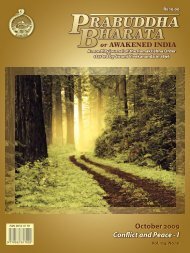P
PB Cover July 2011.indd - Advaita Ashrama
PB Cover July 2011.indd - Advaita Ashrama
- No tags were found...
Create successful ePaper yourself
Turn your PDF publications into a flip-book with our unique Google optimized e-Paper software.
Sri Ramakrishna: The ‘New Man’ of the Age – III 45<br />
Advaitic teachers regard jñāna-mārga as the<br />
only true highway to mukti, whereas the dualistic<br />
teachers regard bhakti-mārga as the only<br />
true pathway to mukti. The first attempt to reconcile<br />
the two mārgas was made by Sri Krishna<br />
in the Gita. But later Vedantic teachers interpreted<br />
the Gita in such a way as to make the<br />
scripture appear to support their own respective<br />
views. The second great attempt to reconcile<br />
jñāna-mārga and bhakti-mārga was made<br />
by Sri Ramakrishna. From his own realization,<br />
Sri Ramakrishna taught that at the highest<br />
transcendent level jnana and bhakti lose their<br />
distinctions and become one; the same happens<br />
with the distinction between saguṇa and<br />
nirguṇa. These distinctions are created by the<br />
human mind at the lower level and have no<br />
meaning at the highest transcendent level. Furthermore,<br />
Sri Ramakrishna taught that through<br />
divine grace even a bhakta who follows bhaktimārga<br />
can have knowledge of Brahman as the<br />
impersonal Absolute.<br />
Sri Ramakrishna has spoken on this subject<br />
several times. Once he said: ‘The path of knowledge<br />
leads to Truth, as does the path that combines<br />
knowledge and love. The path of love, too,<br />
leads to this goal. The way of love is as true as the<br />
way of knowledge. All paths ultimately lead to<br />
the same Truth’ (104).<br />
As regards the controversy about the nature<br />
of Reality, attained through different paths, Sri<br />
Ramakrishna said: ‘He who is called Brahman by<br />
the jnanis is known as Atman by the yogis and<br />
as Bhagavan by the bhaktas. The same brahmin<br />
is called priest, when worshipping in the temple,<br />
and cook, when preparing a meal in the kitchen.<br />
… But the Reality is one and the same. The difference<br />
is only in name. He who is Brahman is<br />
verily the Atman, and again, He is Bhagavan’<br />
(133–4). In another place Sri Ramakrishna said:<br />
‘God has form and He is formless too. Further,<br />
PB July 2011<br />
He is beyond both form and formlessness. No<br />
one can limit Him’ (192).<br />
It is important to keep in mind the distinction<br />
between mārga and yoga. All the four yogas<br />
find application in both the mārgas. In bhaktimārga<br />
the bhakta practises karma yoga; raja<br />
yoga, in the form of meditation; jnana yoga, in<br />
the form of discrimination between the Atman<br />
and the world; and finally bhakti yoga. Similarly,<br />
in jñāna-mārga the jnani also has his own karma<br />
yoga, raja yoga, bhakti yoga, and jnana yoga.<br />
But when it is stated that through any one<br />
yoga it is possible to realize God and attain<br />
mukti, then it should be understood that the<br />
term ‘yoga’ is used in the sense of mārga. When,<br />
for instance, Swami Vivekananda states that<br />
karma yoga by itself can lead to mukti, here<br />
‘karma yoga’ is used in the sense of karma-mārga.<br />
One noteworthy point in Sri Ramakrishna’s<br />
views on spiritual paths is that he never condemned<br />
any path as wrong. Even about the<br />
Kartabhaja sect, which followed certain immoral<br />
practices in the name of sadhana, Sri Ramakrishna<br />
said it was like entering a house by the<br />
small door at the back of a house formerly used<br />
by scavengers to enter the house. According to<br />
him, any path, if sincerely followed, can lead ultimately<br />
to the supreme Goal. The one thing he<br />
insisted on was sincerity, āntarikatā.<br />
Harmony of Spiritual Life and Social<br />
Life · Sri Ramakrishna’s repeated references<br />
to kāmini-kāñcan, woman and gold, as maya and<br />
the main cause of bondage may give the impression<br />
that he was against householder’s life and<br />
social obligations. But the truth is that he fully<br />
understood and approved the necessity of marriage<br />
for most people and the importance of fulfilling<br />
family obligations. He could have avoided<br />
his own marriage if he had been against it. But<br />
he not only gave his consent to it, he even chose<br />
his bride. Apparently, he did so in order to set a<br />
505
















